Yesterday the Scottish Government formally announced its proposals for Phase 1 of its Route Map out of the Covid-19 lockdown. The proposals involve relaxing controls over activities that take place in the outdoors so long as people stay apart: working outdoors, meeting people outdoors and outdoor recreation. While parts of the guidance are excellent and are underpinned by the new law that came into force today, much is undermined by the fear of allowing people, whether living in urban or rural settlements, out into the countryside again. The small print in the guidance will continue to make outdoor recreation in the countryside very difficult, a missed opportunity in terms of people’s physical and mental health and enabling people to get the most out of life. This post takes a look at the issues and the likely consequences.
The revised Coronavirus Restrictions Regulations
Today “The Health Protection (Coronavirus) (Restrictions) (Scotland) Amendment (No. 3) Regulations 2020” (see here) come into force. They comprise a list of amendments to the original Restrictions Regulations (see here). You need to read the two sets of regulations together to understand what the law says.
The new Regulations remove all the references to “emergency period”, not mentioned yesterday but official confirmation that Scotland is no longer regarded as being in a state of emergency. The most significant other changes are to the list of reasonable excuses that enable people to leave their homes legally.
You can now lawfully go out of your home:
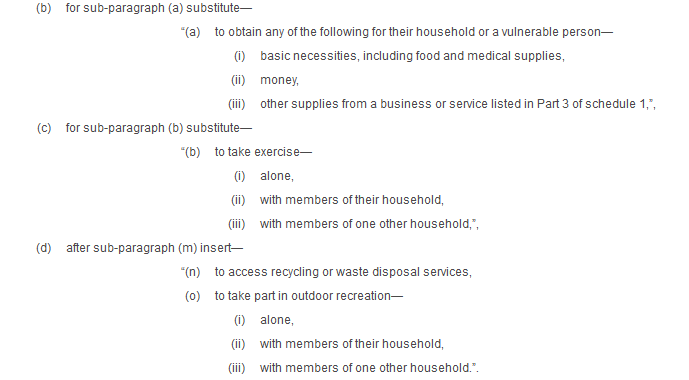
Amendment (b) allows people to go to places like garden centres, (c) to take exercise with members of another household and (d) to go outdoors again for recreation in its broadest sense
Amendment (d) is particularly welcome. It allows people to go outdoors for their mental health and mental well-being and children to go out and play once more. These rights should never have been restricted but unfortunately the Scottish Government has ignored representations on this issue (from people like Andy Wightman, the Green MSP ) up till now. The law now lets you sit in the sun, play in the grass with children or watch birds and the accompanying Guidance makes that clear. Effectively, the right to enjoy almost all the activities covered by access rights has now been fully restored.
The outdoor recreation provision also allows people to drive. Indeed, some might argue that driving in itself can be a form of outdoor recreation. This was confirmed by Ian Livingstone, Chief Constable of Police Scotland, who made it clear at a Scottish Government briefing that police officers would would not be stopping and asking drivers why they were driving once the new law comes into effect.
A possible exception to what is included under outdoor recreation is wild camping, where the law – or how it might be applied – is unclear. The other provisions in the Regulations, which were designed to stop people leaving their homes overnight except for work purposes, are still in force and main message in the government guidance is still for people to Stay at Home, albeit “as much as possible”. Whether the Police could fine or arrest people who were wild camping “to take part in outdoor recreation” is unclear. To wild camp, however, might be an invitation to the Scottish Government to tighten up the law. Given how campervanners have been singled out for social opprobrium, anyone stopping off overnight by a road at the present time – even though this poses little or no risk to others – would risk creating a backlash.
The law as phrased, however, might enable the Government to welcome back campers and campervanners – who stay apart – at some future date without further amendments to the law.
The revised Scottish Government Guidance
The latest Scottish Government guidance on Covid-19 (see here), issued yesterday, confirms that the intention of the new law is that all the informal activities included under access rights – except camping – and a few organised sports like bowls and golf like can re-start. It contains some good advice:
“Before leaving your home you should plan how you will keep safe and minimise risk. For example, consider whether and how you will avoid touching surfaces that others have touched and how you will practise good hygiene.
Also consider circumstances where physical distancing might be impaired and how you will avoid or mitigate the risk.
And consider what additional things you may need to take with you, such as hand sanitiser or a bag for discarded tissues etc.
When we reduce our day-to-day contact with other people, we will reduce the spread of the infection”
AND
“You should use judgement and take part in any activity only if you can do so safely, maintaining physical distancing and not putting yourself or others at risk.
It is important to plan in advance and not take unnecessary risks that may result in the need for medical care or emergency services support.”.
On the basis of this advice, it’s clear that hill walking is included in walking, mountain biking in cycling and kayaking or surfing under watersports. The message is you can take part in activities that might be regarded as higher risk, so long as you are careful about those risks (which everyone should be anyway). That is most welcome.
The problem, however, is the “stay at home”, as much as you can, message, which has become increasingly incoherent – the overriding message should be “stay apart” – coupled with the advice on travel contained in the section on meeting others (see here) :
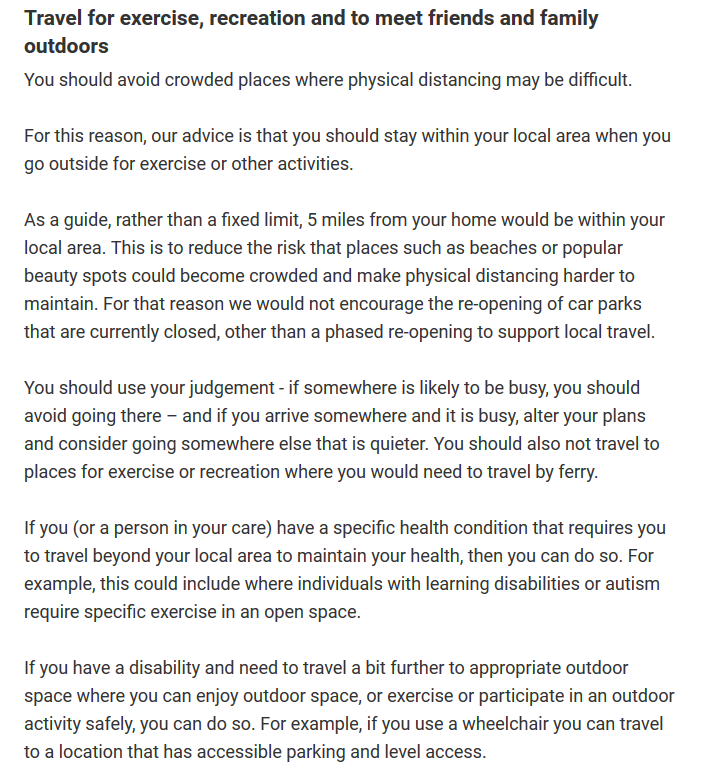
Effectively everyone is being asked not to travel more than short distances and the Scottish Government has endorsed the continued closure of car parks in the countryside.
The rationale for this is that staying in your local area is the best way to avoid “crowded spaces where physical distancing may be difficult”. That is again incoherent. The most crowded places, as I will demonstrate below, are within our settlements. Instead of trying to confine people to where they live the government should be encouraging people to disperse out in the countryside where there are hundreds of square miles of empty space.
The internal contradictions go further. While advised to stay in your local area for exercise, you can visit other households who live further away:
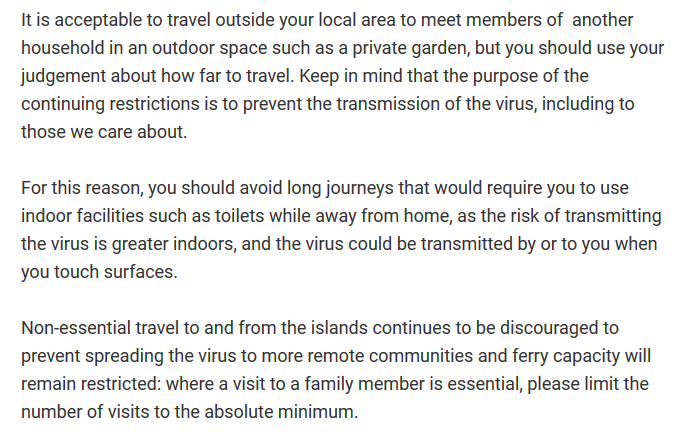
The message seems to be that the Scottish Government is prepared to trust people to use their judgement on how far to travel to see their family or visit someone for the day, including the use of ferries, but NOT for outdoor recreation. Toilets are identified as a key “no no” because they are indoors. On this advice, anyone who has regular bowel movements and is prepared to pee outdoors, can plan their arrangements around that and travel as far as they want to see relatives. Had the Scottish Government applied this principle to hill walkers and other outdoor enthusiasts used to “going” in the countryside, the implication would have been “so long as you take a trowel you can travel as far as you want in a day for a walk”.
The consequences of the advice – outdoor recreation in Glasgow and Whitelee Windfarm
On Monday I cycled from the southside to Glasgow Green then along the Clyde towards Bothwell with my partner. Unfortunately I had left the memory card out of my camera, so no photos. I was out for a couple of hours and I guess we passed 1000 people of all ages, some walking, some running, some cycling. I had taken the train out to Blantyre and run back along the same path in February and it was almost deserted. Even taking account of the fine day and bank holiday, the use of paths and parks in the city has increased dramatically.
Parts of the cycle path beyond Glasgow Green are too narrow to keep two metres away from people, but almost everyone was trying to stay apart as far as they could and there were lots of good natured greetings. To me this shows most of the people using the path realised the importance of physical distancing and that the chances of catching the corona virus from momentarily passing people are very low. More nervous people, and I know some people in that category, avoid using such paths and the parks within Glasgow completely.
By contrast, on Tuesday, I got into the car for the first time in over ten weeks and drove out to Whitelee windfarm for a run and to take a look at the closed car parks for myself (see here). Whitelee is 10 miles from my house as the crow flies, and 16 miles by Google’s recommended route, both significantly longer than the five miles mentioned in the Scottish Government’s new guidance.

When I got to Whitelee, the car park was still closed off and the only place to park was on the road, on the cycle lane. That’s something I had never done before, though it wasn’t unlawful in this case as there was no traffic regulation order prohibiting parking. There were less than a dozen cars parked in all.
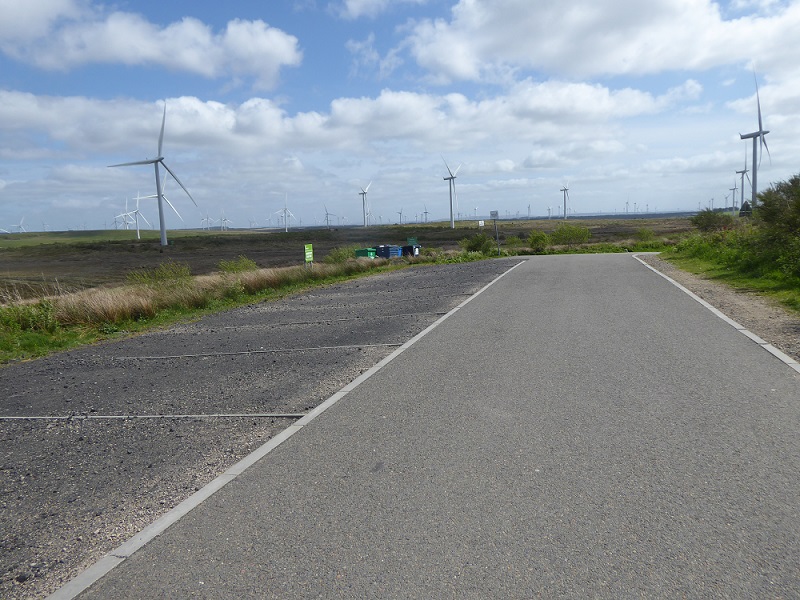
Just beyond the locked gate in the first picture was a large overflow car park. It would have been far safer for everyone to have been able to park in this car park than on the main road.
In its previous Guidance issued three weeks ago, the Scottish Government advised that while most people shouldn’t travel, people with disabilities could travel to find somewhere suitable for exercise. That is repeated in the new Guidance (see above). Whitelee, with its 130kms of generally wide tracks, could have provided an ideal place for people with disabilities and special needs to get out into the countryside. But anyone in a wheelchair, for example, who had tried to visit in the last three weeks would have been forced into trying to get out of their car into their wheelchair on the road. No one with sense would do that. As of today the Whitelee Windfarm website says the car park is still closed. While that is in accordance with the Scottish Government’s advice that car parks can remain blocked off to the public, it’s discriminatory.

If this wasn’t bad enough further car parks have been shut off in the last three weeks. I have a friend whose 90 year old father lives in sheltered housing in a town and had been driving out to go for a walk each day – the sensible thing to do, to escape the crowded streets. However, a week or so ago he found his usual car park taped off and had as a result been forced to walk along the road.
While I heard yesterday that Fife Council, to its credit, has been re-opening car parks, as yet it appears that all the major car parks on the edge of our cities (see here), like at the Pentlands Regional Park or Mugdock Country Park remain closed.
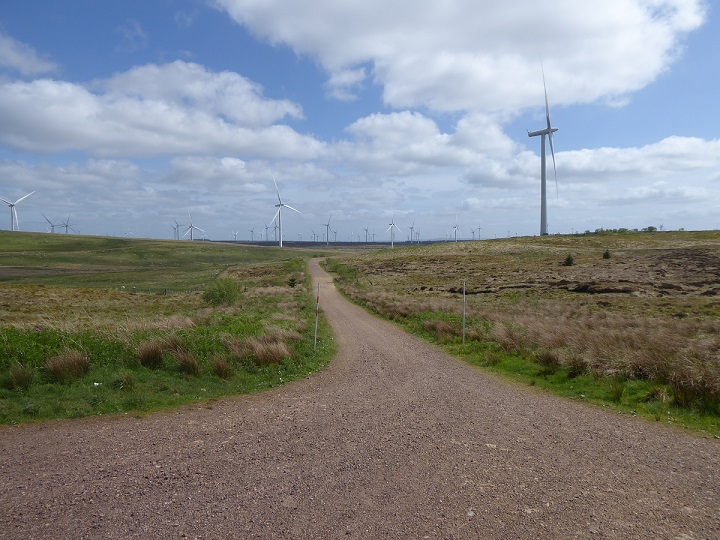
By contrast to the River Clyde foot path/cycle route, Whitelee was almost deserted. We saw about fifteen people in a two hour run. What should have been an amazing recreational resource to the south of Glasgow, which is nowhere near any local community, looks as if its going to continue to be denied to people. This is not the fault of Scottish Power who operate this site, it is the responsibility of the Scottish Government who have so far failed to deliver any effective framework for outdoor recreation.
I personally would be in favour of setting aside parts of places like Whitelee for use by people who are vulnerable as part of the relaxation of the lockdown. The Scottish Government says it’s considering how to meet the needs of the people whom it advises not to leave their homes but has not yet decided what to do. Places like Whitelee, could, with a little management, help people who the government is advising to “shield” to get out in the countryside again and feel safe. There are two entrances, for example, and part of the130km track network could be sectioned off and reserved for people who need to be extra careful.
Windfarms are not my thing. I had avoided Whitelee since it had been constructed and I found the noise of the turbines and the constantly flicking shadows as we by the turbine blades irritating. Despite this, my heart soared from the moment I stepped out of the car: the song of the skylark; the soaring of buzzards; the cotton grass bobbing in the wind; the view back out over Glasgow; feeling the bog beneath my feet.
Everyone deserves to be able to experience such things again and it should be the job of government to enable this to happen rather then prevent it.

Discussion – the politics of breaking government guidance
I thought quite carefully before going out to Whitelee because of what Lord Sumption, one of the few people to have defended civil liberties since the start of the corona crisis, said when asked if he had broken the “rules” (see here). (I don’t agree with all he is arguing for). He smiled and said he hadn’t broken the rules as that would be used to undermine his case.
But in my case, I have been open about breaking certain aspects of the “rules” and the law from the start. I, like hundreds of others, have stood in the street and talked to households I have known, safely spaced, but in breach of the law which has made gatherings of more than two people a criminal offence. That thankfully has now been changed. I have also stopped to enjoy nature or catch the sun when out exercising. That has also changed today, not before time.
Whether I broke the law by driving out to Whitelee on Tuesday is not clear. The Police in England put out guidance weeks ago saying it was reasonable to drive to do physical exercise, Police Scotland had been less clear until Ian Livingstone’s recent clarification of the police position.
What I can state with certainty, however, is that the risks of my spreading the virus last Tuesday, either by transmitting it or catching it, out at Whitelee were far less than they were when I cycled along the Clyde path. If the Scottish Government is still concerned about the risk of spreading Covid-19 outdoors – and the latest guidance continues to be ultra cautious on this saying the risk is “lower outdoors” rather than far lower – then the logical conclusion should be it needs to enable people to disperse out from crowded places in the cities to places in the countryside with plenty of space.
For the people concerned about others going out because they might crash their car or have an accident, I will simply note that I experienced neither and, while it’s always a possibility, the risks are extremely low.
The position now, however, is clear. Going out to the countryside for outdoor recreation is lawful – as long as you observe the Physical Distancing rules – and the rational thing to do if you are concerned about crowded places, is to travel out into the countryside for outdoor recreation.
So what is the Outdoor Recreation “problem” and what are the solutions?
The Scottish Government and the countryside agencies appear to be worried about thousands of people flocking to certain popular places in the countryside. Here is Nicola Sturgeon in her speech (see here) yesterday:
“We simply don’t want, in this phase, to see large numbers of people at tourist hot spots or local beauty spots. Crowds of people – even if they’re trying to socially distance – bring more risk than we judge is acceptable and safe at this point.”
That is exactly what’s been happening in our cities recently, at places like Portobello beach. The numbers will increase as more people start leaving leave their homes under the latest guidance. To the extent that there is a risk, the government is making it worse through trying to limit how far people travel and the closure of car parks.
The Scottish Government is also clearly very concerned about the risk of Covid-19 being transferred through hard surfaces at public toilets. Together this explains the Scottish Government mistaken advice that it is acceptable to keep toilets and car parks closed
The answer to the potential breakdown of physical distancing at tourist hot spots is to manage visitors. Scotland has far far more space than England and, what’s more, unlike England almost all the countryside is covered by access rights. With a little bit of management, it would be quite easy to avoid the sort of scenes that have been happening on the beaches near Bournemouth and Whitby.
However, that needs government:
- To trust that people want to avoid transmitting the virus and will as a consequence follow advice on how to reduce pressure on areas that are likely to be crowded. The longer the Scottish Government keeps people confined to the more crowded places in towns and people become habituated to passing by others in close proximity (even if momentarily), the more the Scottish Government risks undermining its own advice. The Physical Distancing advice is right but for it to continue to work, people need to be able to disperse.
- To provide people who normally only visit one or two places in the countryside they know well, whether Largs beach or Balloch, with lots of other suggestions of where to go. Government needs to say “please think three times before going to such and such a place” and “why not try these alternatives”. Instead of marketing just a few places, our National Parks could provide dozens of suggestions to people where to go. A more extensive core path network might have really helped with this.
- To put in place arrangements to manage particular hotspots. For example, use police or countryside rangers to direct people away from villages like Balmaha or Balloch, well before they get there and as soon as the car parks start to become fuller than is safe. A Car Park App, on the model of that being used in the Lake District National Park, could be used to direct people to less busy car parks. The Loch Lomond and Trossachs National Park Authority could also adapt its camping permit software to enable people to book in advance the busiest car parks such as at Balmaha. While that should not be allowed to set a precedent, it would be far more constructive than keeping car parks closed indefinitely.
- To put in place proper arrangements for cleaning public toilets. The risks of transmitting Covid-19 is being overstated and used as an excuse to keep the countryside shut. With a bit of care – again that requires our public authorities to trust people – there are only a few hard surfaces within toilets that people need touch. As long as numbers entering toilets are controlled, as they are in shops to maintain physical distancing, and hand washing is strongly promoted, people could use public toilets safely.
One underlying problem is that most of our Public Authorities (the Loch Lomond and Trossachs National Parks with its large ranger service is an exception) have had their budgets cut to such an extent that they will find it very difficult to provide such visitor management at present. NGOs, like the National Trust for Scotland and the RSPB, face similar problems. If the Scottish Government wants rural tourism to get going again its needs to address these issues and quickly.
This problem is linked to the perception that visitors are a problem, an unnecessary expense which is best managed by banning people from undertaking certain activities while still taking their money. The origins of this lie in the creation of the camping byelaws in the Loch Lomond and Trossachs National Park. Sadly I predict that the LLTNPA, which should act as the lungs of the Glasgow conurbation and should have been the first place to open its car parks and toilets under the routemap out of lockdown, will be the last to do so.
The consequences of the continued closure of car parks and toilets is deeply discriminatory. There is nothing now to prevent experienced outdoor folk from going out and enjoying the countryside again. You just need to know places where you could walk or kayak or whatever that don’t require the use of cordoned off car parks. For others, however, who need access to car parks (such as people with disabilities), toilets (particularly important for Older People and families with young children) or who are less certain where to go, effectively there is still a ban on visiting the countryside.
For experienced outdoor folk, the main concern will be about having their cars vandalised by vigilantes who are misguidedly trying to stop anyone visiting the countryside. Most people in the countryside are not like that but, having friends living in rural areas who have not dared to drive for weeks now, even to the most deserted places, I know this is an issue for outdoor folk whether they live in urban or rural areas.
We need to address this fear that is still stalking the countryside. The fear of crowds is a manifestation of a much deeper problem and that, I believe, has driven the Scottish Government’s decision to continue to discourage people from visiting the countryside even for the day. If they fail to tackle that, its not just Outdoor Recreation that will suffer, the rural economy will collapse and fall even further into the hands of the billionaires and multi-national companies (see here).
Thank you, Nick, for yet again articulating the commonsense view. To anyone with experience of “going to the outdoors” (as well as “in the outdoors”), the Phase 1 guidelines are utterly ludicrous. This is so obviously an attempt to make people stay away. It is insulting.
I see East Ayrshire Council have opened up Dean Country Park in Kilmarnock. So hopefully others will quickly follow this example.
Yes, well done East Ayrshire and thanks for reporting this…………..
Hi,
It will be interesting to see how many car parks are gradually opened over coming days and weeks, i noticed many car parks being blocked of with large stone boulders of piles of soil and rubble, i cant imagine local councils will be in any rush to open any of these car parks up due to effort involved in removing the objects placed. Certainly today the first car park at mugdock as you come up from the resivours at milngavie was still blocked of with cones today, with same signs up saying car park was closed.
The fact that forestry and other public car parks remain closed is unbelievable and, as Jane says, insulting. It in effect, means that in practice, little has changed – obviously the thinking behind it, which will do nothing other than increase the resentment which was already building up. All this will result in is either people removing the barriers and parking anyway (as I witnessed yesterday) or parking on the roadside causing safety and access issues. It certainly won’t stop most people from going out. The majority of people travel by car for various reasons so cycling/public transport is not a viable option for most, therefore car parks must be reopened before there is a major incident caused by inappropriately parked cars (dogs, kids, even adults do not mix well with passing traffic-the whole reason for having car parks in the first place) and, as Nick mentions, a safe place to park with adequate space is critical to a lot of people with disabilities.
Additionally the 5 mile guidance is pretty ludicrous and doesn’t open up many, if any, options. For people living in big towns and cities, it would be lucky to get you out of a built up area, for others in more rural areas it would likely allow you to get to the next layby (which will probably be taped off anyway!). It certainly doesn’t provide much scope for visiting friends and ‘loved ones’. How many of us live within a 5 mile radius of each other?
While many restrictions are still necessary to hopefully bring us out of this in a safe a way as possible, it’s about time NS et al started to use some common sense where the outdoors is concerned and did actually start listening to people, as she claims to do. Perhaps by bringing Parkswatch and Nick’s reasoned articles to her attention? Let’s hope local councils and the national park see sense, even if she doesn’t.
The Pentland Hills Regional Park is supposed to be opening car parks “next week”. That’s according to the BBC, there is nothing on the PHRP website to confirm.
Maybe the good weather this weekend will force the issue, remember it is the police who are driving the car park closures and they are the ones who have to deal with the consequences of continued closure.
Completely mad situation in East Lothian today, all costal car parks seem to be closed which was causing Chaos and mayhem. Basically a free for all with cars parking on any road side space they could find, with added danger to all involved, and must be worsening tension in local towns of aberlady, longniddry and gullane rather than making it better. The aberlady bay car park closure in particular made no sense as it’s a good two mile walk out to the beach from there, and once on the beach your granted with a view of 1km long open sand with probably 20-30 people spaced out, never going to be a problem with over crowding, even Gullane beach was fine, and greeted with mad sight while walking up Gullane hill of seeing a closed car park while the access road above the car park was full of parked cars, it’s hard to understand the action of councils in keeping car parks closed, by the looks of it your getting the same amount of visitors but with significant increase to people health from dangerous parking.
I think it seems harder for people to understand what 5 miles is.
Hey ho give an inch and well they take as much as they want.
Really wonder why we do not just bin the the whole social distancing thing and just make it the free for all that some wish for….
What can possibly happen, Nick?
Good luck
There are two completely different things here, travel into the countryside and keeping apart when there. Trying to stop people travelling and dispersing makes matters worse, not better. How do you think confining people into settlements reduces risks?
Some positive action from the police for these self centred entitled individuals.
https://www.bbc.co.uk/news/uk-scotland-glasgow-west-52892409
Take more care out there.
I think charging people who need rescued up a mountain is clearly wrong and creates a dangerous precedent and can hopefully be challenged in court.
There is no law in Scotland just now restricting travel for excerise, and I imagine Munro’s have been climbed by thousands of people traveling more than 5 miles since lockdown was eased.
The problem here is the the walkers were inexperienced poorly equipped and made poor judgement choices. But did they really endanger anyone during the rescue process? I am imagine it’s fairly easy to help navigate stranded walkers off a hill side while maintaining social distancing, with little risk of transmitting the virus in an outdoor environment.
Are we saying now the outdoors is only for people who are experienced? As far as I am aware people are allowed to make mistakes and maybe more education is needed, but everyone from mountain guide down to first time walker could potentially sprain and ankle etc and require assistance, but charging the walkers basically says to me that no one is aloud outdoors because if you get hurt or require assistance you will be prosecuted
I note the charge, of culpable and reckless conduct NOT breach of the Coronavirus Regulations. Culpable and reckless conduct is deliberate conduct that exposes an individual, or the public generally, to significant risk to life or health. “As the name of the crime suggests, the conduct has to be reckless. This means acting with a complete disregard of (or indifference to) the consequences of his/her actions. You cannot commit this crime accidentally or carelessly”. As I read it, for these charges to stick the Procurator Fiscal will need to be able to show that the two people – whose experience clearly wasn’t sufficent for Beinn a Choin, which is quite a tricky hill – went out with a reasonable expectation that they might need to be rescued and put the rescue team at risk. If found guilty of that, there will be considerable implications for Mountain Rescue across Scotland. We will see. To confuse matters Mountain Rescue Scotland’s criticism was that the two people had flouted the latest guidance. This is guidance, not law, and one can ask that when John Swinney stated on the radio he welcomed the new guidance as it would enable him to travel down to Edinburgh and see a parent in their garden (I am not sure where he lives but 40 miles away?) is it so wrong for someone to drive a similar distance and go for a walk? There is of course no rational answer to that. Driving is safe. It’s what people do when they get to place that matters and that means staying apart. If people put themselves in a situation where they need to be rescued they are undermining that and deserve to be criticised, but not for the travel.